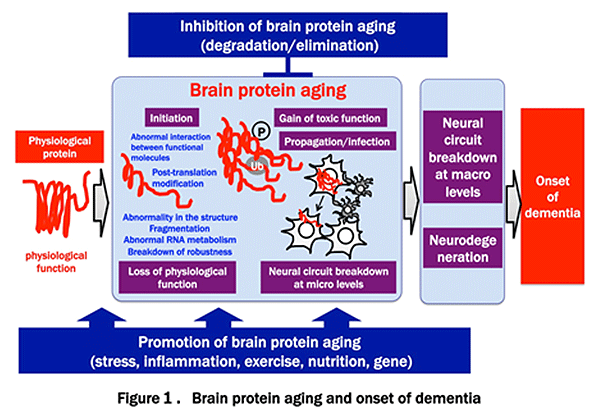About Our Research
Purpose of the Research Project
In our country as well, prevention and control of dementia occurring in as many as 4.6 million people are one of the most challenging issue imposed on medical sciences of the 21st century. Major molecular pathologies reside in broken neural circuits due to physiological dysfunction of proteins comprising the neural system and due to their acquisition of toxicity and pathogenicity. In the current field, we defined such toxicity-acquiring processes of functional proteins as “brain protein aging.”

The current research field has newly arisen to answer the following essential questions: Why brain proteins age and acquire toxicity; How neural circuits fail and bring about dementia; and What therapeutic interventions can eventually prevent dementia. This research field is expected to create a path to brain protein gerontology applying all of the next generations of advanced technologies. The study will take an interdisciplinary approach to analyze chronological changes of brain proteins, in particular, from normal to degeneration and also from various angles at the molecular to individual levels.
Content of the Research Project
The current field comprises “Brain protein aging and neural circuit breakdown (A01),”“Molecular basis of brain protein aging (A02),” and “Development of therapy for brain protein aging (A03).” A01 is aimed at the development of visualization of human brain protein aging and neural circuit breakdown, and specific PET imaging of aged proteins, while A02’s purpose is to elucidate mechanisms of brain protein aging and neural degeneration, qualitative and quantitative constancy of proteins (robustness), and mechanisms of aged protein accumulation and its propagation and spreading. A03’s task is to clarify mechanisms of brain protein aging using two innovative model systems and to clarify the aging process of brain proteins using brain imaging for Primates.
These three research projects are organically combined to accomplish the following targets: (1) Clarification of the mechanisms of initiation and pathogenicity of brain protein aging; (2) Clarification of the mechanisms of aged brain proteins’ intercellular transmission and infectiveness; (3) Clarification of the mechanisms of pathogenicity acquired by aged brain proteins and its inhibition, and the development of clinical markers; and finally (4) Visualization of brain protein aging and clarification of the mechanisms of neural circuit breakdown.
Expected Research Achievements and Scientific Significance
Dementia and neurodegenerative disease share the molecular bases of protein aging. These molecular bases are jointly explored by a variety of researchers from basic and clinical fields of medicine with new eyes and methods. In addition, next-generation technologies are incorporated, aiming at developing novel research fields of brain protein aging. The current field will be developed as a new academic field by a eclectic mix of such researchers as those who are able to analyze functions or dynamics of brain functional proteins, those who are able to create iPS cells or primate models, those who are able to study the mechanisms of initiation, progression and removal of aged proteins, those who are able to visualize pathogenetic proteins in mice and Primates, and those who are able to evaluate and verify protein aging. Results of the current study project are expected to lead to the development of epoch-making drugs for dementia as well as other various diseases associated with brain aging.

